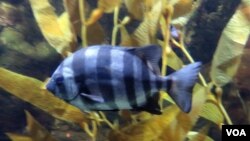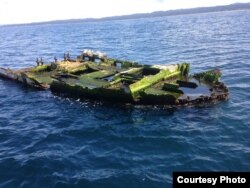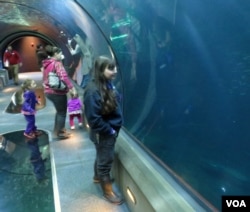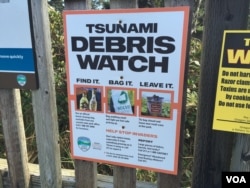The Oregon Coast Aquarium is home to hundreds of aquatic species ... including two that arrived unexpectedly after a trip across the Pacific, trapped in the hull of a derelict fishing boat.
Their story began five years ago, on March 11, when Japan was shaken by the largest earthquake ever to hit the island nation. The quake and resulting tsunami left more than 15,000 people dead, and crippled several nuclear reactors.
As the waters rolled back out to sea, so did millions of tons of debris. It began washing up on West Coast beaches in 2012 and a trickle is still coming in; some of the bigger pieces of flotsam — fish and other marine life from Japanese waters.
Marine life washed in from Japanese waters
Last April, staff from the Oregon Coast Aquarium rescued more than a dozen yellowtail jacks and one striped beakfish from a half-sunk, fiberglass wreck coated in seaweed. It was the front half of a roughly 15-meter-long commercial fishing vessel.
The long-distance hitchhikers were kept in quarantine for six months before being judged safe and suitable to display in the Newport aquarium. Assistant curator Evonne Mochon Collura said DNA testing positively identified the adult fish as native to East Asian waters.
"We don't know how old they are," she said. "We don't know how long they were in the hull. It's possible they got washed into the boat hull when they were small."
They probably survived by nibbling on sea life that grew inside the hulk and whatever else washed in.
Foreign fish
The beakfish shares its tank with a second beakfish that was pulled up in a crab pot two months before the drifting boat hull showed up off of Newport.
The other new arrivals are in the much larger "Open Sea" tank. The 11 yellowtail jacks that came through the quarantine period look like big silver torpedoes with deeply forked yellow tails. They swim in a tight school around the tank, which also holds numerous sharks. But Mochon Collura said with a smile that the sharks are well fed by the aquarium staff to curb their appetite for the foreign fish.
Watching for aquatic invaders
While the beakfish and jacks are thrilling visitors to the Oregon Coast Aquarium, they are invasive species. So government agencies and marine biologists up and down the West Coast continue to watch out for more tsunami debris and hitchhikers.
John Chapman, a marine expert at Oregon State University, said Pacific Northwest coastal waters are probably too cold for these refugees to reproduce. But there are lots of other potential invasive species that worry him, including sea stars, seaweeds and parasites that could displace native species.
"Yeah, there are real bad characters in that debris," he said.
Fortunately, the volume of suspected tsunami debris washing up on Pacific Northwest shores has tailed off in past year. What's left out there is getting harder to distinguish from all of the other trash in the ocean. Chapman said it appears the region has lucked out.
Observers remain vigilant
However, he acknowledged, sometimes it takes a long time for an invader to become established. So the marine scientists will keep vigilant.
One of the main methods of surveillance is to lower metal or plastic discs in the water to see what grows on them. They generally sit out for one to three months before being hauled up and scrutinized for unwelcome critters and organisms.
Hundreds of these so-called fouling panels have been deployed along the coast from California to Alaska. In addition, trained observers are making periodic checks for sea life that’s out of place on the undersides of coastal docks and pilings.
The Japanese government donated $3 million to support debris dispersal modeling and coastal monitoring around the Pacific Rim.













